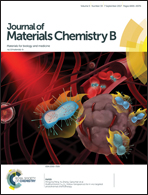Strontium folic acid derivative functionalized titanium surfaces for enhanced osteogenic differentiation of mesenchymal stem cells in vitro and bone formation in vivo†
Abstract
The introduction of the bioactive strontium (Sr) element has become an attractive method in the design of bio-functional layers on titanium surfaces. However, there are still no effective solutions to some of the associated problems including the toxicity of free Sr2+ ions and the rapid and irreversible loss of the strontium element from the bio-functional layers. In this study, we successfully fabricated a bioactive layer on Ti substrates with a strontium folic acid derivative (FASr). About 3.11 at% Sr was incorporated into the Ti surface. The characterization results showed that FASr was stable over a long period of time and minimal free Sr2+ ions were detected in simulated body fluid (SBF). In the in vitro experiment, the FASr could significantly promote the cell adhesion, proliferation and osteogenic differentiation of mesenchymal stem cells (MSCs) over a short period. Furthermore, it could dramatically accelerate the bone formation around the implant. In vivo, a total of 30 7-week old male Sprague Dawley (SD) rats were applied for implantation tests. The results showed that this positive stimulatory effect became more evident in the later stages of the in vivo observation. This study provides an effective strategy for designing and optimizing Ti-based implants.



 Please wait while we load your content...
Please wait while we load your content...